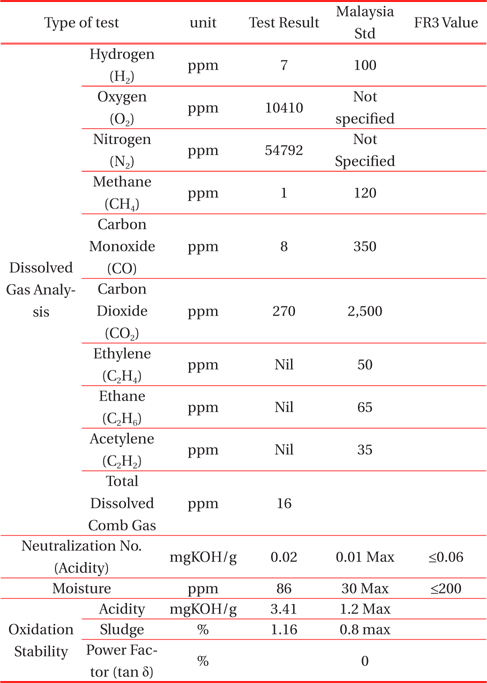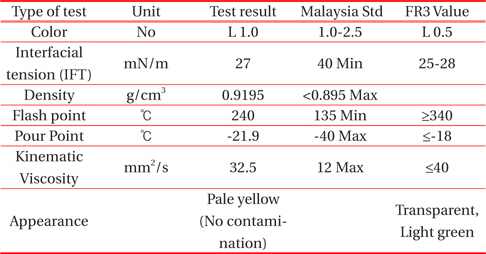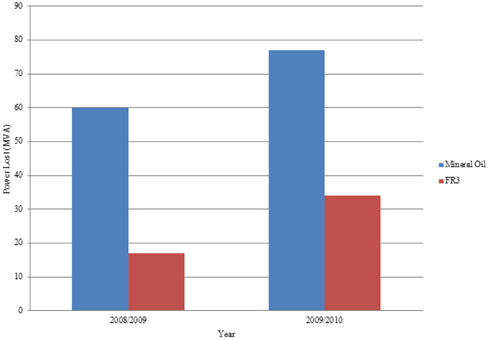



The importance of transformers in the power system cannot be overemphasized. The power transformer is required in the power system to step up or down generation or transmission voltages for the use of commercial or residential electricity consumers in industries, shops/markets and homes. The reliability and performance of the power transformer depends upon the properties of its high voltage insulating materials, whether it is acting independently or in composite with one another. The principal insulating materials in any oil filled transformer is kraft paper or pressboards. It insulates the intra and inter turn windings, and the insulation oil acts as both the insulator and heat exchange medium [1].
Of these two, the one that is the most susceptible to contamination is the insulation oil. Hence, it is important to consider the choices of insulation oil available to use in transformers.
Reasons such as, performance, cost and availability make petroleum based insulation fluid the most common insulation fluid for oil filled transformers [2]. As much as electrical power system engineers try to prevent it, transformer faults and accidents still occur and when they do, transformer tanks can rapture, causing large quantities of the non-biodegradable mineral oil to spill onto the ground [3]. The transformer can also explode, causing the highly flammable oil to ignite and burn profusely. These two reasons were primary in necessitating the extensive research to find alternative insulation oil that is biodegradable with high flash and fire points amongst other advantages. By the end of the 19th century, vegetable oil had been successfully developed for commercial use and is currently used in many power transformers with remarkable performance. record [4].
Most of power transformers used in Malaysian power system networks are filled with petroleum-based mineral oils as insulation fluid. These transformers contain large quantities of mineral oil and can be disastrous to the environment in cases of tank ruptures or leaks [6]. The objective of this study is therefore to undertake a critical examination and ascertain the properties of a natural ester vegetable oil sample (Envirotemp® FR3™), comparing it with the Malaysian Standard for oil filled transformers as well as carry out a cost benefit analysis and environmental impact assessment of using the oil in Malaysian power system transformers.
A sample of the natural ester oil, from the manufacturer, was tested according to the SIRIM certified standard MS 2322:2010
The result of the test and analysis is presented in the next section.
The result of the Envirotemp® FR3™ natural ester oil sample tested was compared to the standard values given by MS 2322:2010 and the properties of ester given by the manufacturers of the oil [7]. The Electrical, Chemical and Physical property results of the sample of oil tested are summarized in the tables 2 to 4 below
[Table 1.] Electrical properties of sample vs FR3 and MS.

Electrical properties of sample vs FR3 and MS.
[Table 2.] Chemical properties of sample vs FR3 vs MS.

Chemical properties of sample vs FR3 vs MS.
[Table 3.] Physical properties of sample vs FR3 vs MS.

Physical properties of sample vs FR3 vs MS.
The result shows that the Envirotemp® FR3™ tested based on the Malaysian Standard MS 2322:2010 has
i. Higher moisture content ii. Higher dissipation factor iii. Higher pour point iv. Higher neutralization value v. Lower Inter Facial Tension (IFT)
3.2 Cost benefit and performance assessment
Based on the information given on power transformers tripping that were recorded in the financial year (FY) 2008/09 and 2009/10 by TNB and the 2003 International Machinery Insurers’ Association (IMIA), and a worldwide study on the analysis of transformer failures over a period of five years between 1997 to 2001 [8], it showed losses due to transformer insulation failures in Malaysia. It compares power lost using mineral oil compared to what it would have been if FR3 were used. The summary is shown in Figs. 2 and 3 below
Furthermore, the use of the natural ester, biodegradable Envirotemp® FR3™ insulation oil can reduce this cost because the oil.
i. Has a higher breakdown voltage; thus reducing risk of insulation breakdown at lower voltages. ii. Has a higher flash point; thus less risk of failure due to fire [9]. iii. Has a higher viscosity and so has higher heat dissipation rate; reduced operating temperature. iv. Absorbs moisture expelled from kraft paper; therefore reducing its degradation rate and failure due to aging [10-12].
This study has established that natural ester/vegetable insulation oil
i. Has a higher dielectric breakdown voltage than mineral oil, implying that it can withstand higher electrical stress under the same operation and environmental conditions. ii. Has a higher susceptibility to absorb moisture from the kraft paper, which is better than mineral oil. This characteristic of ester oil is uniquely important as it reduces the rate of kraft paper degradation and so elongates the life cycle of the transformer [11-15]. iii. Is compatible with all components of the transformer because the long chain fatty acid structure of the oil makes it non-corrosive; it has negligibly low chemical reaction with the other transformer components [16]. iv. Has a high flash point, which invariably reduces the risk of transformer fires due to insulation oil burning after arcing faults inside the transformer. v. Also has a high thermal withstand characteristic resulting from the high flash point [17]. vi. Can be cost effective in terms of maintenance, operations and performance. vii. Is environmentally friendly and ease to dispose without fear of toxicity to the eco system
So far, the major cost disadvantage for this oil is that it is not readily available and so its initial cost is higher than that of mineral oil as shown in Fig. 4 below.
3.3 Environmental impact assessment
In this century, almost all engineering equipment designed without the consideration of their impact to the sustainable development of the society (protection of the eco-system) or safety of their operation can be deemed as failures. Therefore, environmental impact assessments of any new engineering design is essential for sustainable development. The impact of engineering equipment is so important that existing equipment are being redesigned to fit our fragile ecology.
Therefore, in terms of the environment, natural ester insulation oil
i. Is biodegradable and eco-friendly. It contains no toxic chemicals. ii. It has no waste disposal issues because it is perfectly eco friendly. iii. The source is renewable. iv. No fire hazards when compared to mineral oils because of it high flammable level.
4. CONCLUSIONS AND RECOMMENDATION
The Malaysian climatic and weather conditions are unique with high humidity, frequent rain, and a lot of lighting [19]. So it is pertinent that new insulation oil proposed to be used in the power frequency transformers are tested before use. The test should compare results with existing standards and show the effect regarding the unique Malaysian weather on the biodegradable insulation oil Envirotemp® FR3™ when used in local environmental conditions. At the end of this study, it was established that the feasibility study showed that the commercially available biodegradable insulation oil could be introduced in Malaysian power transformers either as new insulation oil or as retro-fill.
The cost benefit analysis is based on postulations that arrived with reference to previous studies on transformer failures worldwide, as there was little data available from the public utility company, TNB, despite the enthusiasm of that the VP TNB Transmission had in this research. The only information available from TNB were the number of transformers in the power network in Malaysia and unsigned causes of transformer tripping recorded in the financial year (FY) 2008/09 and 2009/10.
With this conclusion reached, it is therefore recommended that further work on this project should
i. Apply the oil in a transformer and monitor its performance; retro filling will serve this purpose because the oil is compatible with the other transformer components. ii. Seek more statistical data from TNB, in order to have a more accurate cost benefit analysis (Including claims for damages and litigations). iii. Seek the development of Malaysian Standard for biodegradable insulation oil filled transformers. iv. Develop palm oil to use as insulation oil to make natural ester oils readily available and cheap.
![Filling a transformer with environtemp FR3 [5].](http://oak.go.kr/repository/journal/13447/E1TEAO_2014_v15n3_113_f001.jpg)





![Initial cost of insulation oils [18].](http://oak.go.kr/repository/journal/13447/E1TEAO_2014_v15n3_113_f004.jpg)